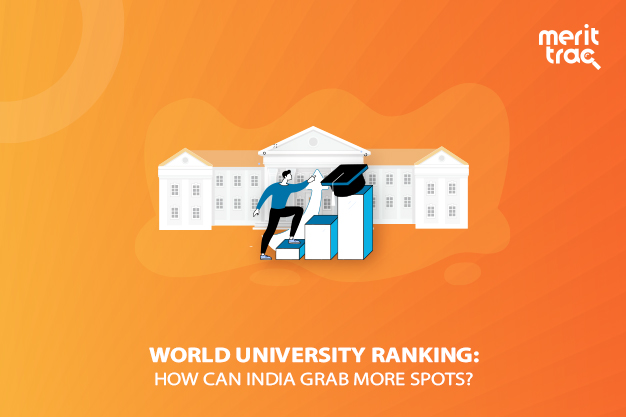
World University Ranking: How can India grab more spots?
Date: 23/09/2020 | Posted by: MeritTrac | Category: General
In the latest World University Ranking, only two Indian universities made it to the top 400 institutions. While Indian Institute of Science (IISc), Bangalore found a place in 301-350 group, IIT Ropar made its place in the 351-400 bracket, as per the ranking released by the UK-based Times Higher Education (THE).
This year, 14 more Indian universities were qualified for the rankings compared to the last year. However, the top-seven IITs refrained from partiicapting in the rankings voicing concern about its transparency.
This helped some of the newly formed IITs grab a spot among the top-800 institutions. IIT Indore grabbed a spot in the 401-500 bracket and 15 other institutions grabbed a spot in the 600-800 bracket. Last year, three Indian universities grabbed spots in the top 400.
Globally, over 1,500 universities from 93 countries were ranked, with the Oxford University of the UK topping the list, followed by Stanford University and Harvard University. China's Tsinghua University topped in Asia with an overall rank of 20.
Ails behind India’s abysmal performance
The annual rankings are prepared based on a host of parameters, the final rank is the result of performance in each parameter. The ranking is based on 13 carefully calibrated performance indicators that measure an institution’s performance across four areas: teaching, research, knowledge transfer and international outlook, says THE website.
While the University of Oxford got 91.3, 99.6, 98.0, 68.7 and 96.4 points for teaching, research, citations, industry income and international outlook respectively, India’s IISc got 58.1, 53.1, 31.9, 87.6, and 22.1 points.
The above pointers implicate while Oxford focuses on teaching, research and international outlook, IISc is way behind in these indicators, whereas, the industry income is higher than Oxford. Hence, it is evident that India needs to re-focus on improving teaching quality, research output and international outlook.
For years, the Indian education system has suffered from several drawbacks. One of the major reasons is the funds allocated for education. The funds allocated for education is lower than the Constitutionally mandated 6% of GDP. Also, a majority of that fund is spent on elementary education rather than higher education.
Another major gap in the Indian education system is the skill gap. Instead of acquiring the right set of skills for a certain career, the higher education courses are often seen as a medium to earn remuneration after course completion. This approach sometimes makes fresh graduates jon a career/job for which either they don’t have the right aptitude for or don’t have the skillset for. This ultimately leads to a huge skill gap.
Education and skill gap
Unemployment in India is a critical challenge despite a huge number of students passing out every year. The major reason for this staggering unemployment is the skill gap. A very less percentage of the students passing out from the Indian higher education system are employable. In other words, there is a huge gap between the education system and industry expectations. To eliminate this gap, there should be a conscious two-way collaboration between industry and higher education institutions .
As a major company in assessment and testing in India, MeritTrac offers various services and solutions to overcome this issue. AceTrac, the employability skill development assessment solution helps institutions to assess the employability skills of the students and plan strategies to improve the employability. This also helps the corporate organizations to understand the competencies of their prospective candidates and devise a proper future approach.
Recently, MeritTrac launched an Extended Curriculum Program (ECP) in order to help the institutions produce industry-ready graduates. From soft skills to niche skills in cutting-edge technologies such as AI-ML, big data analytics, modern sales and others, the program has developed a host of supplementary courses for the students. The company also offers assistance for jobs and career development. This is the kind of effort educational institutions will have to put in if they want the quality of education to improve in India.
India aspires to become a world education hub, infact, the recent National Education Policy (NEP) shares this vision by allowing foreign universities open their branches in the country, thus, increasing the competition as well as the education quality. Additionally, the Policy has recommended allocating 6% of GDP for education. However, the higher education system needs urgent attention from all the stakeholders towards improving the research quality as well as bridging the industry skill gap.
Reference:












 Sales Hotline: USA: +1 646 916 0939 / Others: +91 80619 14700
Sales Hotline: USA: +1 646 916 0939 / Others: +91 80619 14700


